Breeding a litter can be a wonderful experience for both the owner and the dog.
Whether you’re a first-time breeder or you’ve raised a number of litters over the years, it’s important to note that this is a full-time job.
Dog breeding is not something everyone can do. You have to be well prepared and educated before you even indulge in it.
It is expensive, time-consuming, exhausting, and sometimes, it can be heartbreaking. Not to mention how sleeping quickly becomes a luxury once the puppies arrive.
But after all of the sweat and tears, it is totally worth it. Your dog gets to enjoy the wonderful days of motherhood, and you get to take care of the puppies along the way.
In this article, we explain dog breeding in detail. Are you a corgi owner that wonders how to breed a corgi?
If the answer is affirmative, then continue with reading and learn more!

What To Know About Breeding Corgis?
Dog breeding should begin with knowledge. Responsible and ethical breeding means you are familiar with your dog breed, and you’re continually learning how to improve it and not just increase its numbers.
While no dog is perfect, every good dog breeder strives for perfection, all while sticking to the standard.
The standard is essentially the blueprint of each dog breed. According to it, every breed has its own ideal characteristics that every dog breeder should strive for.

What Are Corgis Bred For?
Almost every dog breed is developed to do certain tasks.
What are corgis bred to do? What are corgis breed for?
In the case of corgis, they were bred for herding many centuries ago.
And not just that. They were also bred for vermin hunting, protecting the livestock from predators, and as an all-purpose farm dog.
Responsible dog breeders will also know that it is important to avoid ‘kennel blindness’, which means they will objectively examine their dogs and figure out a way to improve and balance all of the faults they might have.
The flaws may come from the dog’s personality, temperament, structural soundness, ability to thrive, looks, or overall health.
The main motto of every dog breeder should be ‘Breed to improve’. The goal is to produce healthier and better puppies that are not prone to health issues or injury and look like their breed.
The breeder should also take into consideration the breed’s original intended function and preserve it for future generations.
Many corgi breeders nowadays are exaggerating the bad characteristics of the breed. For example, they often breed corgis to shrink them in size, change their eye or coat color, or their shape.
Why?
Because they are trying to please the general public.
But that is not a fair and responsible thing to do.
These breeders don’t pay attention to a dog’s bloodline, genes, temperament, or health issues. That results in poor quality puppies, which are prone to many health problems.
Dogs with any kind of issue shouldn’t be bred on. It could be a temperamental problem (aggressive or shy dog), structural, or health issue (back problems).
It’s sad but necessary. Dog breeders are often challenged not to get their emotions involved in the judgment. And sometimes, deciding a particular dog shouldn’t be bred is very hard.
At the end of the day, a dog breeder should always look at the bigger picture – an improved next generation of a particular breed.
As a future dog (corgi) breeder, you should study your breed’s standard, read books related to this topic, attend dog shows and online courses, and speak to vets and other dog breeders.
This way, you will gain more knowledge, experience and be one step closer to your reputable dog breeder title.

Examining Your Dogs
Once you’re well-read and familiar with the process of dog breeding to the bone, the first step is to examine your dogs.
Suppose you already have a dog, and you’re unsure whether she is ready to be a mom. You first need to take her to the vet to make sure she’s up to date on vaccinations. It’s imperative since antibodies are passed on the puppies through the milk.
Next off, your dog should be dewormed. Dangerous worms like heartworms, roundworms, or hookworms can easily be passed from the mom dog to her puppies.
It’s crucial to know your dog’s medical history and find out everything about her bloodline and genetics. If your dog has any health problems, the puppies will likely have the same issues or even worse.
The most common are malocclusions, hip or elbow dysplasia, spine problems, allergies, eye problems, skin or ear infections, heart conditions, or behavior problems.
As for corgis, the common health concerns are:
- Degenerative Myelopathy
- Von Willebrand’s Disease
- Dystocia
- Stalled Labor
- Eye conditions
- Hip Dysplasia
- Intervertebral Disk Disease
- Epilepsy
One other thing you should check is a breeding soundness exam. This includes Brucellosis test for both male and female dogs, as well as semen analysis for the male dog.
Lastly, health testing on your female dog should also include:
- Eye exam
- Blood tests
- Progesterone tests
- Orthopedic exam for hip and elbow problems
- DNA testing
- Thyroid testing
- Heart tests
- Hearing tests

How To Breed A Corgi: Corgi Reproduction 101
Around six months of age, puberty or sexual maturity occurs in female dogs.
Smaller breeds can go into ‘heat’ much earlier, and some females experience ‘heat’ as early as 4 to 6 months of age. On the other hand, it can take up to 2 years for some larger or giant breeds to come into heat.
When speaking about corgis, males’ puberty’s average onset age is around 6 to 8 months old. Female corgis’ average heat cycles happen every six months. Females also tend to be slightly older when the first heat occurs, around 9 to 11 months old.
Understanding The Terms
Before we continue any further, let’s discuss the dog breeding terms first:
| 1 | Bitch: | A female dog |
| 2 | Dam: | The female parent of puppies (mother) |
| 3 | Heat: | The stage in the female dog’s reproductive cycle during which she is fertile and can mate with a male dog |
| 4 | Estrus: | A heat period |
| 5 | Litter: | The number of puppies born at the same time from the same female dog |
| 6 | Season: | Dog menstruation |
| 7 | Sire: | The male parent of puppies (father) |
| 8 | Stud: | The male dog that mates with the female dog (bitch) |
| 9 | Whelping: | A female dog giving birth |
| 10 | Whelp: | A puppy |
Now that we got this clear, it’s time to explain the reproductive cycle of dogs.
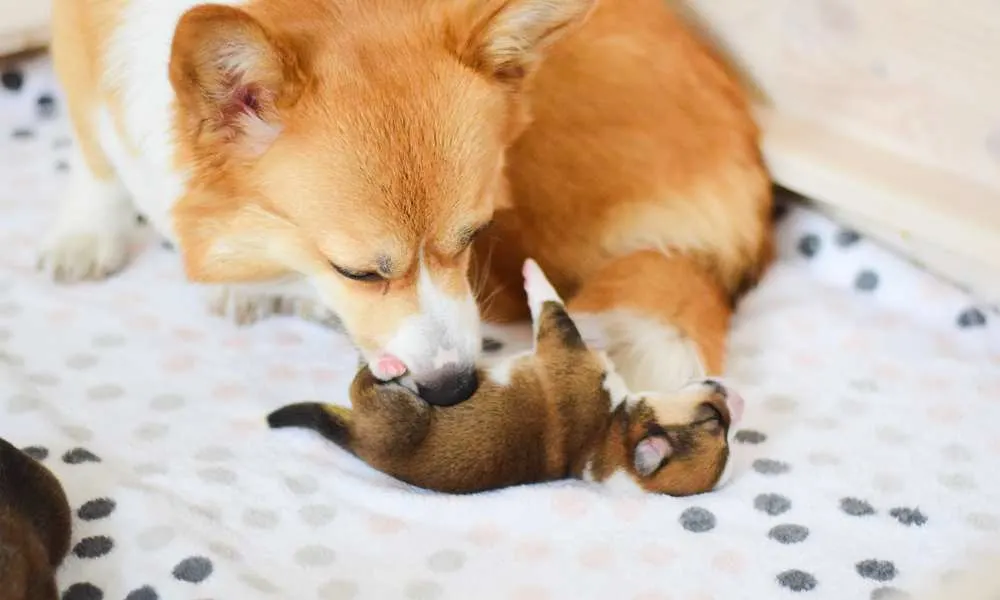
The Reproductive Cycle
To understand when is corgi breeding season and when to breed corgi, we first need to learn about the dog’s reproductive cycle.
Female’s heat cycle lasts from 18 to 21 days. Bitches (female dogs that have not been spayed) usually have two heat periods (estrus) per one year, which are 6 months apart.
Each heat period lasts around 2 to 3 weeks, during which they can become pregnant.
The first heat occurs between 6 and 15 months old (when it comes to corgis 9-11 months old). The pregnancy can also happen on the second or any heat period later on.
As for the male dogs, they don’t have a sexual cycle. However, they can sense whether the female is in her heat period and respond. They are also most fertile when fully mature.
Estrous or Heat Cycles In Female Dogs
Female dogs have 4 stages of heat. Let’s take a look at the table below:
| STAGE | DEFINITION | LASTS | SIGNS |
|---|---|---|---|
| Proestrus | Start of heat | 7-10 days | Vulva swells, and blood flows. Females attract males but will not allow mounting during that period. |
| Estrus | Mating period | 5-20 days | Blood flow lessens and stops. Females attract males and allow mating. Ovulation also occurs during this time, 2-3 days after mating usually. |
| Diestrus | The period 10 to 140 days after heat | 60-90 days | The dog is either pregnant or in the resting phase. The vulva returns to its normal size; the bitch will no longer accept a male for mating. |
| Anestrus | The resting period between diestrus and the next heat cycle | 4 months or longer | The vulva isn’t swollen, no vaginal discharge. |
NOTE: In order to make sure that the breeding is taking place at the right time, you should take your bitch to the vet for blood tests, vaginal smears, and serum progesterone tests. You can do this before the heat cycle and throughout the entire heat cycle.

Is The Female Dog (Bitch) Suitable For Breeding?
A bitch should only be bred if she’s fit and healthy and shows a good temperament.
She should also pass all of the health checks with flying colors. That’s because any serious health conditions will be passed on to her puppies.
You should also take her age into account. A bitch should be at least one year old and has to have a full season already before attempting to mate.
The older the dog, the more serious complications may arise. The risks of whelping and mating begin to increase at around eight years old, or even earlier.
Generally, the best time for the bitch to be bred for the first time is upon maturity. However, it shouldn’t be done before her second or third heat cycle.
If you want to register the litter with the Kennel Club, both the bitch and the stud must be KC registered and meet specific criteria.
The Kennel Club most likely won’t register her puppies if:
- The bitch has whelped 4 litters already
- The dam is over 8 years old
- The bitch is under one year old
- The litter is produced through mating a dog with its relatives (father and daughter, son and mother, sister and brother)
- The dam has had two C-sections
Of course, sometimes exceptions can be made if you have supporting evidence from a vet or under special circumstances.

Are Corgis Easy To Breed?
The million dollar question here is:
Are corgis hard to breed? – Well, no.
Corgis are actually an easy breed to work with, unlike other small dogs. However, being small dogs, corgis tend to have difficult pregnancies that oftentimes require C-sections.
| Are Corgis Inbred? | Are Corgis Overbred? |
|---|---|
| The inbreeding coefficient for corgis is 8,9%. This indicates that corgis were subjected to backcrossing and inbreeding to a reasonable degree. | Technically, they are because of the recent increase in their popularity. |

Are Corgis Purebred?
Yes, they are. By the late 1920s, the UK Kennel Club recognized corgis as purebred dogs.
Have you ever thought which corgi breed is better?
Generally speaking, Pembroke Welsh Corgis are a more wanted breed. They are high energy, very friendly and affectionate, and more outgoing. On the other hand, Cardigans are more reserved than Pembrokes, but they do warm up quickly too.

Are Corgis Deformed?
Corgis do have a medical condition called achondroplastic dwarfism. It’s because of the gene called fibroblast growth factor 4 or so called FGF 4, which affects only their limbs and causes them to have shorter legs.
As for the lack of tails in Pembroke Welsh Corgis, they were docked throughout the history because the breeders didn’t think they were necessary for their herding purpose.
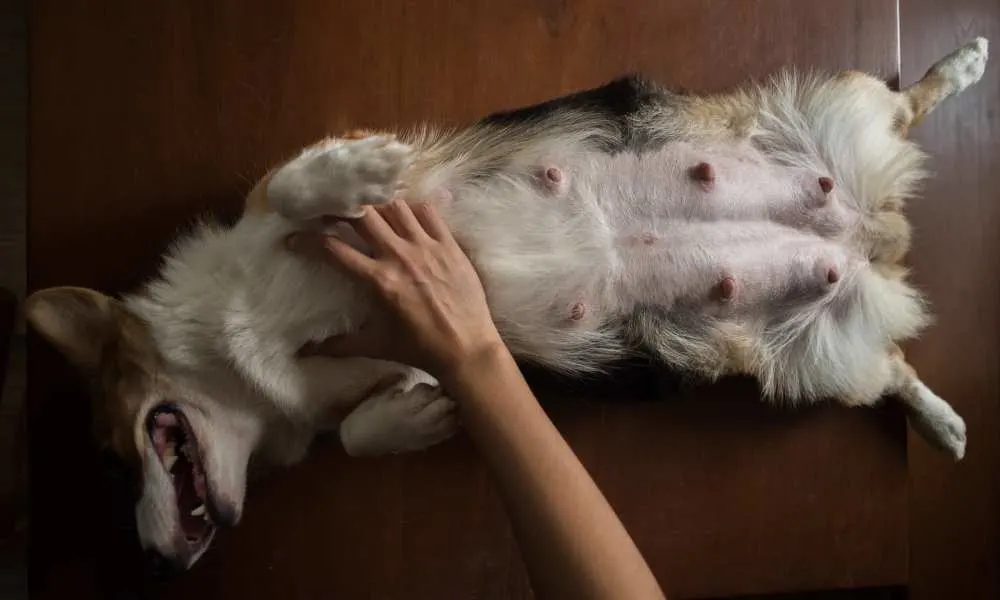
How Often Should A Bitch Be Bred?
Upon insemination, the sperm will last inside the female for 5-7 days.
As soon as the bitch is willing to stand, she should be bred every 2-3 days until she no longer accepts the male.
Two or three matings altogether are considered good enough.
She will have healthy sperm inside of her when she ovulates, when the eggs are ripe and when they’re dying later on.
A female dog that is in heat and doesn’t want to be bred by the male may need a little assistance. It is best to consult an experienced breeder or a vet, as they can show you the best way to restrain your dog and help with mating.
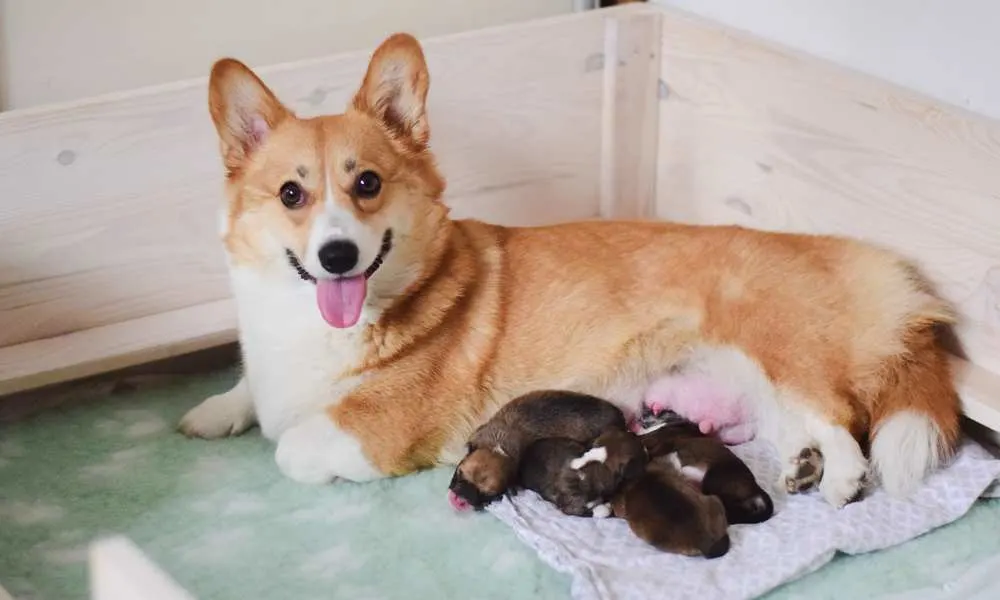
Is It Okay To Breed A Bitch Immediately After The First Pregnancy?
That depends on her body condition and how many puppies she whelped the first season.
If she had several puppies and was weak and thin by the time they were weaned, she probably shouldn’t be bred again as she can’t regain normal body condition before she’s in heat again.
If your female dog seems to be in excellent body condition and she only had a few puppies and no C-section, she may potentially be bred again.
Nevertheless, every bitch is an individual case and thus, should be evaluated accordingly.

Finding A Good Stud Is Essential
Dog breeding is not just a form of science but also a form of art. When looking for a good partner to mate with your bitch, you want to examine your dog first and look for all the faults she might have.
After you know her weak traits, you will know what to look for in the stud.
The idea is to strive for perfection and learn how to balance out the faults your dog has.
For example, if your female dog could have a better coat, then look for a stud that comes from a line of dogs with good coats. The same goes for every fault you may find.
After months of research and evaluating different studs, you have to weigh out all the pros and cons for each dog and make a decision.
Now, this decision could be great or could be a disaster. That’s why breeding comes with certain risks, as you can never be 100% sure.
Nevertheless, when looking for a suitable mate for your bitch, you have to look at the dog’s entire pedigree. From his phenotype (how he looks) to his genotype (his background), to his ancestors’ health and temperament.
You have to question everything.
If the particular stud has already had litters in the past, you may contact those breeders and ask them about their opinion about the puppies’ quality.
Other questions which you can also ask the stud owner:
- Does he/she ship chilled sperm? Does he/she do it by himself or at a vet? If yes – have the chilled breedings been successful?
- How much does he weigh?
- How old is he?
- Has he had litters in the past?
- Does he have a good appetite?
- What’s his temperament like (does he get along with other males, dogs, or children)?
- Does he have any health issues?
- Does he have a scissor bite or undershot bite?
- Has he been tested for Brucellosis?

Sign A Stud Contract
Once you have selected the perfect mate for your bitch, it is time to work on the mating details.
Before breeding takes place, you should sign a contract with the stud owner. All parties should sign the deal, and each signer should have a copy.
The contract regarding stud fees should clearly state all obligations and circumstances.
It also covers several different things, such as a guarantee for the puppies (one or more per litter), an agreement that the puppies should be placed in appropriate homes, etc.

How Do Corgis Mate?
Male dogs are more stress-sensitive during mating, and that’s why successful matings are more common when a male is in its own environment.
A female dog is typically taken to the stud and not the other way around.
As we’ve already mentioned, two or three matings in total are considered the standard. The time between the matings should be 24 or 48 hours apart.
If the female does not become pregnant due to the stud’s service, the owner’s of the male dog will often offer a free service next time. Make sure to check all of these details with the owner of the stud before the breeding.

Natural Breeding
I’m sure you’ve been thinking – ‘can corgis mate naturally?’
Sure they can.
To understand how corgis were made, here’s a detailed explanation of the natural mating process:
Mating occurs when the male mounts the female from behind and grasps her midsection with his front legs. The male dog will start thrusting until he eventually penetrates and ejaculates inside the female.
Right after the thrust pass, the female and the male will stay ‘tied’ in position from back to back. The dogs will remain tied between 10-30 minutes, during which you shouldn’t separate them.
What causes the tie?
The dog’s penis, called bulbus glandis, enlarges during coitus and is held firmly by the contracted muscles of the female’s vagina.
If you try to separate the dogs which are tied, you can easily upset them and cause serious injuries to both dogs. Don’t pull them, throw buckets of cold water or other; just wait for them to part naturally.
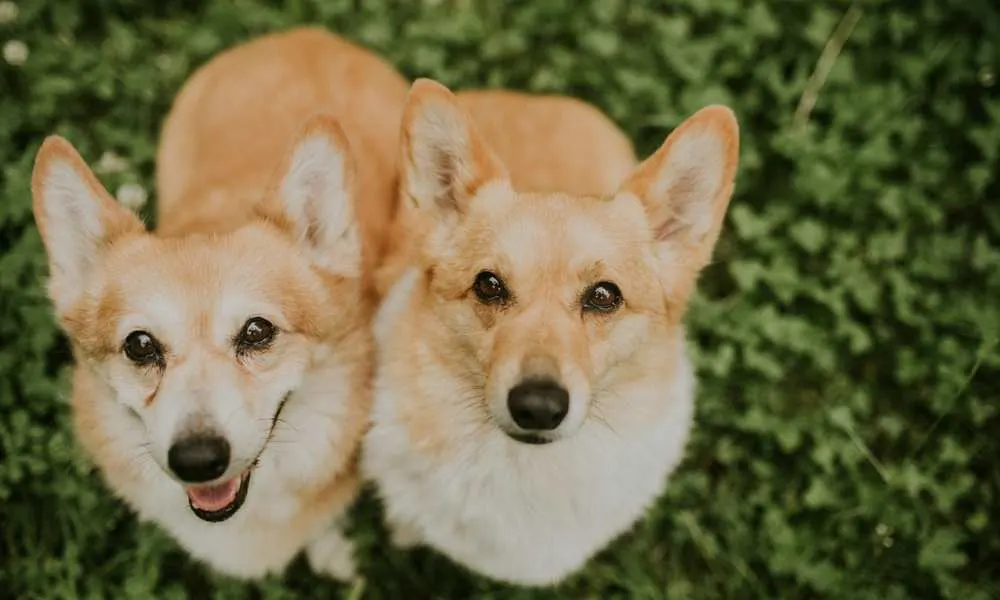
Artificial Insemination (AI)
If natural breeding isn’t possible for any reason, artificial insemination can be used to breed the dog. This can be done at home by an experienced breeder or at the vet clinic.
Dog semen can be easily shipped around the world frozen in liquid nitrogen. There are specific steps that need to be taken to thaw the semen and inseminate the female dog.
The mating can be done using fresh semen, fresh extended semen, and frozen semen. Of course, there are certain rules provided by American Kennel Club for registering a litter bred by artificial insemination.

Helping With Mating
There are a few things that you can do to help with the mating:
1. Don’t let the male eat on the day of mating
That’s because if the male dog is full, it’s possible he wouldn’t have the energy to breed. He has to be energetic and enthusiastic, so it is best to withhold the food until both owners are sure the mating is done successfully.
2. Keep both dogs calm
The environment and the dogs should be calm on the day of the mating. If the dogs are nervous, successful mating is not likely to occur.
3. Make sure the dogs meet prior to the mating day
You should make sure the dogs meet a few days prior to mating, so they could know each other a little bit more and be more relaxed.
4. Help the dogs if necessary
Sometimes males are not sure what to do, or they are much shorter than females. If this is the case, help the dogs using your hands to guide the male dog towards the right area gently.
Also, if the female dog is much smaller than the male dog, you might have to hold her so she doesn’t collapse under his weight.
5. Give the dogs some privacy and don’t separate them
A little bit of privacy may have a huge impact on successful and stress-free mating. Try to keep your distance, and don’t interrupt them or try to separate them by force.
6. Don’t rush the dogs
You have to have patience, especially if the male dog is inexperienced. The dogs might not mate immediately, and it could take a while before they get into a ‘tie’ position.

What Should You Do After The Breeding?
After successful mating, we advise you not to let your female crouch to urinate for at least 20-30 minutes. Also, if the male’s penis doesn’t retract naturally after 30 minutes, you might have to do it yourself.
If you’re a female owner, you can let your dog stay with male owners for a couple of days until the mating is over, or you can take her home with you. Both are fine.

Gestation And Whelping
The gestation period in dogs is only 63 days from the time of conception. The number of days can vary if the eggs are fertilized a few days after mating or if the bitch has been bred two or three times.
In order to determine whether the bitch is pregnant, a vet may manually palpate her abdomen 21-25 days after the breeding. At 28 days, puppy heartbeats may be heard with the stethoscope.
After 40-45 days, a pregnancy may be confirmed with an ultrasound or an X-ray.
It’s crucial to mention most bitches whelp naturally, but some may need assistance. Usually, shorter and smaller breeds may undergo C-sections in order to deliver live puppies. Unfortunately, there’s an increased number of reported C-section cases in corgis over the last couple of years.
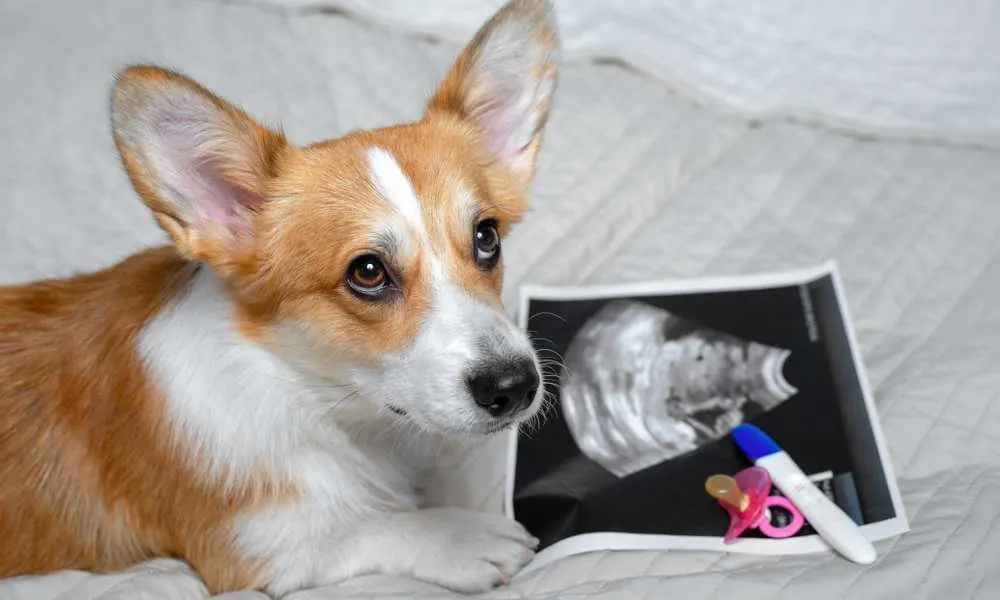
Signs Of Pregnancy
Signs of pregnancy are apparent:
- Weight
- Bigger appetite
- The nipples will get bigger because the glands will start to fill with milk
These can also all appear when a bitch has false pregnancy too. For this reason, you should do an X-ray or an ultrasound after 28 days.

Keep Your Dam Healthy
After the breeding, a bitch should be fed well-balanced, high-quality dog food. The diet should include vitamins such as calcium and should be prescribed by your vet.
The calorie intake should remain the same and should be increased gradually. By the time of whelping, she may be eating 35-50 percent more than usual as her weight increases.
Do remember that corgis are a smaller breed, and so larger meals can cause discomfort to the bitch. Make sure to feed frequent, small meals instead.
Some breeders feed their bitches more protein in the form of liver, milk, eggs, or meat. However, that isn’t always necessary and should only make 10% of the bitch’s daily food intake.
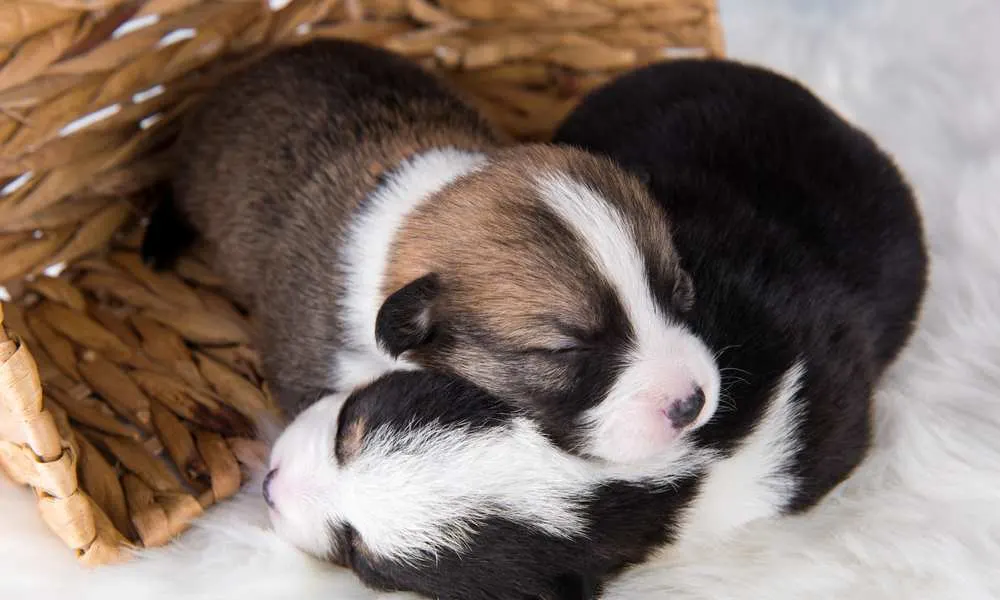
Whelping Box
The whelping box is used to deliver the puppies. It should be 6 inches longer than the female when lying prone and about a foot wider. This will prevent her from laying on the puppies after she delivers.
Also, it’s not a bad idea to get a whelping box prior to delivery so the bitch can get used to it.
This is important if you don’t want her to choose your closet or other inappropriate room to make a delivery.
The whelping environment has to be warm, quiet, dry, and away from the other dogs. You can also place the newspaper at the bottom of the whelping box and easily change them after they get soiled.
Add clean towels or other bedding to provide a better footing for the puppies.
Other whelping supplies:
- Newspaper
- Bath mats
- Paper towels
- Regular clean towels
- Thermostat
- Heating pad
- Scissors and Iodine (to cut the placenta or the puppies’ umbilical cords and to clean puppies’ abdomen)

Be Alert
Don’t let the due day surprise you. It is essential to educate yourself about the stages of labor.
There are a few signs that will indicate she will go into labor. Namely, she may stop eating and start building a nest (preferably in the whelping box).
Her body temperature will drop from 100 or 102,5 degrees to 99 degrees. She will appear restless, paint and strain.
If your female dog has strong contractions and after 30-45 minutes at most, she doesn’t give birth to a single puppy, it is a red flag she may need assistance or a C-section.
For this reason, it is advisable to have your pregnant bitch X-rayed at 45 days of gestation. That way, the vet may inform you on how many puppy skeletons are there and if there may be any large puppies that may cause delivery problems.
Nevertheless, when the delivery day comes, make sure you have your vet on the phone just in case something goes wrong.

What Causes Small Litters?
No one can tell for sure, but it is possibly because the breeding took place at the wrong time. Other possible causes are different infections (uterine), hypothyroidism, or the age of the bitch.
See Also: How Much Is A Corgi Certificate?

Conclusion
There you have it – a complete and in-depth guide on how to breed a corgi.
The most important thing to learn before deciding to indulge in the dog breeding business is to be well informed and educated and remember to do it for the right reasons.
Responsible breeding always has to be done to improve the breed as a whole and not increase its numbers or exaggerate the traits people seem to like.
There are rules and breed standards a breeder must obey in order to produce quality and healthy litter.
We advise you to write down all of the pros and cons of dog breeding. If you by any means can’t commit fully to the furry part of your family, then maybe dog breeding isn’t for you.
Breeding takes devotion and patience. It can be stressful, time-consuming, emotional, and at one point, you will have to put your entire life to the side.
And don’t forget that if you want to start a breeding business, you will have to invest a good amount of money in your dogs.
However, if you’re up for the task and you’re genuinely aware of all of the risks, then it is time to allow your corgi to experience the joys of motherhood for the first time.

